Types of Asparagus Fern: Foxtail, Plumosa, Sprenger (Including Caring for Asparagus Fern Plant)
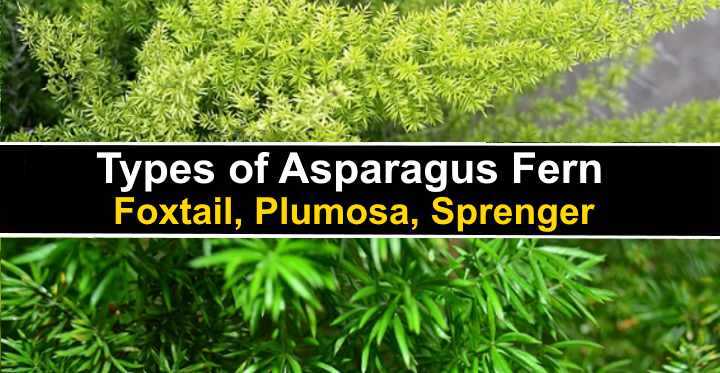
Asparagus ferns are a species of ornamental plants with feathery, fern-like leaves that grow in attractive clumps. Despite their name, asparagus ferns are not a real type of fern but are perennial plants in the plant family Asparagaceae. Common types of asparagus ferns are foxtail ferns, plumosa ferns, and Sprengeri ferns.
Asparagus Fern Facts
Identifying types of asparagus ferns can be confusing. Some species of these fern-like plants have various common names and botanical names. For example, the popular asparagus plumosa fern has the botanical names Asparagus plumosus, Asparagus setaceus, and Protasparagus setaceus.
Ornamental plants in the genus Asparagus are called ferns because they look like ferns. Pictures of asparagus ferns and their foliage show that the feathery asparagus leaves are remarkably similar to real ferns.
Real ferns belong to the plant class Polypodiopsida, and these plants reproduce by spores. However, asparagus fern plants in the class Asparagaceae produce seeds.
Asparagus fern leaves are a type of cladode. Botanists describe cladodes as flattened leaf-like organs in asparagus that are necessary for photosynthesis. For simplicity, we will refer to asparagus fern cladodes as leaves in this article.
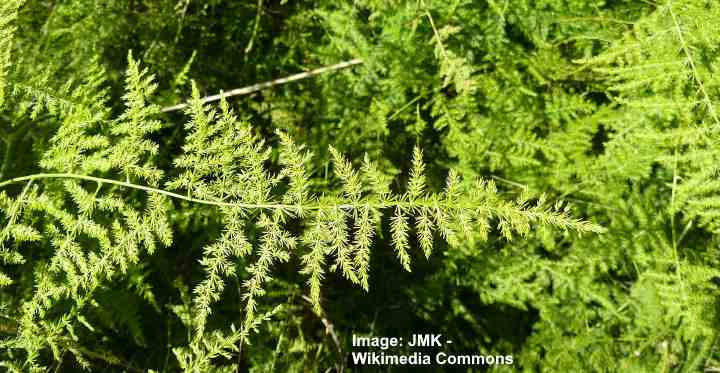
The leaves of asparagus plumosa fern (in the picture) are actually leaf-like flattened stems that are called cladodes
Unlike real ferns that never flower, asparagus ferns produce small white or pinkish flowers in spring. After flowering, asparagus ferns produce little green or red berries.
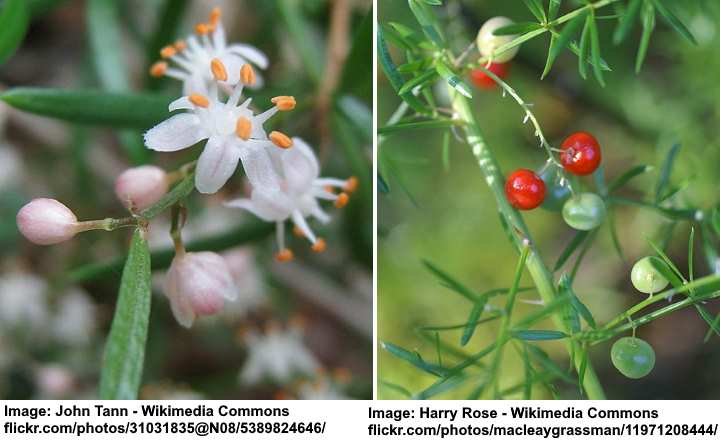
Flowers and berries of Asparagus densiflorus ‘Sprengeri’
When growing asparagus ferns outdoors, it’s vital to remember that they can become invasive. Asparagus ferns have spreading, tuberous roots that grow vigorously in USDA zones 9 to 11. It’s best to grow asparagus fern plants in containers, whether you grow them as easy houseplants or want to add greenery to your backyard, patio, deck, or balcony.
How to Care for Asparagus Ferns – Overview
Asparagus ferns are easy-care evergreen houseplants that thrive in homes. Grow asparagus ferns in partial shade and protect them from direct sunlight. Water asparagus fern plants once a week or whenever the top layer of soil dries. Mist regularly to keep humidity high and fertilize monthly during the growing season.
Types of Asparagus Fern Plants (With Pictures)
Here are some of the most common varieties of asparagus ferns.
Asparagus Foxtail Fern (Asparagus densiflorus ‘Meyeri’)
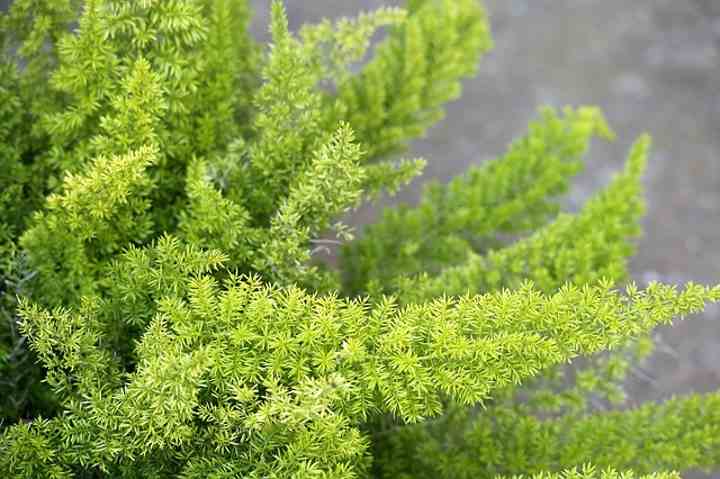
Asparagus foxtail fern
Foxtail ferns have clumps of bushy plumes that resemble a fox’s tail. Beautiful arching plumes contain bundles of needle-like leaves, giving the light-green foliage a soft, delicate appearance. As a flowering plant, asparagus foxtail ferns produce clusters of tiny white flowers followed by red berries. Foxtail ferns are hardy, drought-resistant plants.
Asparagus foxtail ferns grow up to 2 ft. (0.6 m) tall and spread up to 4 ft. (1.2 m) wide. These fern-like bushy plants thrive in USDA zones 9 to 11. Outdoors, asparagus ferns are fast-growing ground cover plants best grown in morning sun with light shade in the afternoon. However, they will also thrive indoors in containers that are protected from direct sunlight.
Other common names for asparagus foxtail ferns include plume asparagus and the asparagus fern. You may see this asparagus fern cultivar listed as Asparagus densiflorus ‘Myers’, Asparagus densiflorus ‘Myersii’ or Asparagus densiflorus ‘Myersi’.
Sprenger Asparagus or Sprengeri Fern (Asparagus densiflorus ‘Sprengeri’)
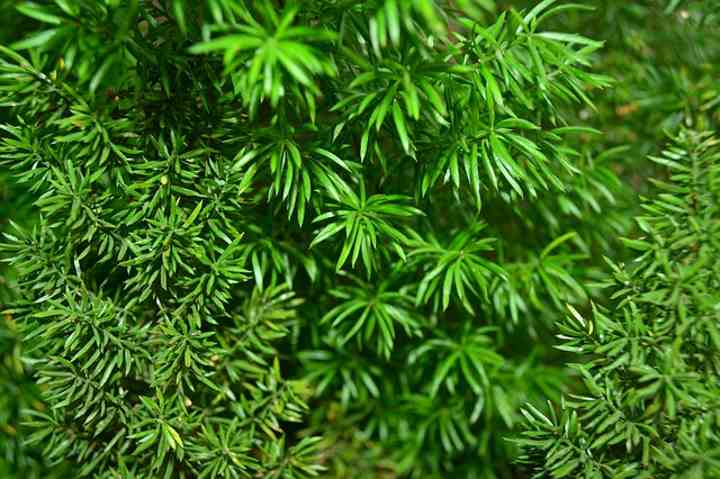
Sprenger asparagus fern
Sprenger’s asparagus ferns have long, arching fern-like leaves densely covered with clusters of soft needles. The Sprengeri fern’s airy emerald-green foliage looks like a type of fern plant. This Asparagus densiflorus cultivar has blossoms of white flower clusters and green berries that turn bright red.
Sprengeri asparagus ferns grow up to 3 ft. (1 m) tall. The long, cascading needle-like foliage is stunning as a hanging basket plant. Outdoors, these asparagus ferns grow best in containers in a sunny spot in the morning and partial shade in the afternoon. Sprenger asparagus ferns thrive in zones 9 to 11.
Another common name for Sprenger’s asparagus is the asparagus emerald fern.
Some botanical references also give Sprengeri ferns the botanical name Asparagus aethiopicus. However, other botanists say that Asparagus densiflorus and Asparagus aethiopicus are separate species of asparagus plants. This asparagus cultivar also has botanical names Asparagus sprengeri and Protasparagus densiflorus.
Compact Sprenger Asparagus Fern (Asparagus densiflorus ‘Sprengeri Compacta’)
The ‘Sprengeri Compacta’ is a cultivar of Asparagus densiflorus with small, compact growth. Compact asparagus ferns grow up to 2 ft. (0.6 m) tall with a spread of 4 ft. (1.2 m). The airy, fern-like sprays are light green and cascade over the sides of hanging baskets.
Grow compact Sprenger asparagus ferns as a semi-evergreen garden plant outdoors all year long in zones 9 – 11. Compact asparagus ferns are also ideal in containers indoors if you live in cold regions.
The minimum temperature for growing asparagus ferns outdoors is 55°F (12°C). However, all asparagus ferns thrive when the temperatures average 70°F (21°F).
Dwarf asparagus fern (Asparagus densiflorus ‘Nana’)
Dwarf asparagus ferns have emerald-green feathery leaves but are smaller and more compact the plumosa fern. The small asparagus ferns grow up to 15” (0.4 m) tall. Due to its small growth, the ‘Nana’ asparagus fern is an ideal houseplant for growing in pots.
Asparagus Plumosus or Asparagus Plumosa Fern (Asparagus setaceus)
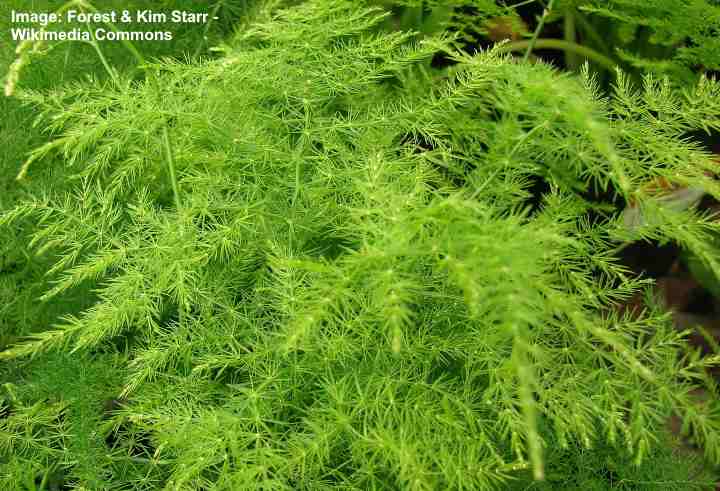
Asparagus plumosa fern
Asparagus plumosa ferns have rich-green feathery flattened sprays, just like a real fern plant. Plumosa ferns have fast growth, and the scrambling light, airy plumage has soft, needle-like leaves. Plumosa ferns also produce greenish-white flowers in the shape of a bell and green berries that gradually turn black.
Asparagus plumosus ferns are easy-grow ornamental houseplants. The fern-like plants thrive in indoor conditions if they get enough indirect sunlight. As an indoor plant, plumosa ferns are excellent for hanging baskets or growing on a windowsill.
Outdoors, plumosa ferns thrive in zones 9 to 11 in dappled shade away from direct sunlight, where they can become invasive. The best recommendation to grow asparagus ferns is to plant it in pots outdoors to prevent them from becoming invasive.
The long climbing stems of the asparagus plumosa fern can grow between 10 and 20 ft. (3 – 6 m) tall.
The plumosa fern gets one of its botanical names—Asparagus plumosus—from its plume-like foliage. However, the plant is also called Asparagus setaceus, Protasparagus setaceus—Latin for “hairy” to describe the plant’s leaves. Other common names for the plumosa fern include the lace fern, common asparagus fern, ferny asparagus, and asparagus grass.
Asparagus plumosa ‘Nanus’ is a dwarf cultivar of the plumosa fern.
Ming Fern (Asparagus retrofractus)

Ming fern
Ming asparagus ferns are large leafy perennial shrubs with light fern-like flattened sprays. The needle leaves grow in tufts or clusters along woody stems. A feature of Ming ferns is the branches that grow in a zig-zag pattern. Although the foliage appears soft, sharp spines grow on the branches.
Ming ferns typically grow to between 6 and 8 ft. (1.8 – 2.4 m) tall. The shrubby asparagus plant has evergreen foliage and thrives outdoors in zones 9 to 11 in bright indirect light or filtered sun.
Ming asparagus ferns have the common names pom-pom asparagus ferns, Chinese Ming fern, and zig-zag shrub. There are also many botanical names for this plant, including asparagus macowanii, asparagus myriocladus, and asparagus macowanii ‘Myriocladus.’
Climbing Asparagus Fern (Asparagus scandens)
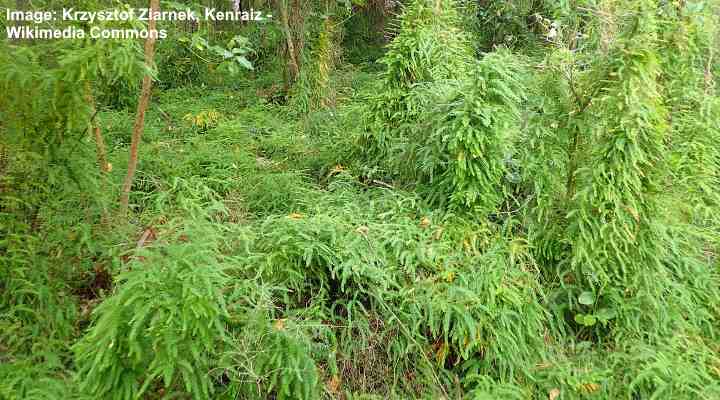
Climbing asparagus fern can be invasive if grown outdoors
Climbing asparagus ferns have scrambling feathery leaves that grow up to 8 ft. (2 m) high. The delicate green foliage is made up of thin needle-like leaves on the flattened branches. In spring, clusters of tiny white flowers appear before giving way to orange-red berries.
Climbing asparagus ferns or “krulkransie” can grow up trellises or arbors to provide year-long greenery in warm climates. Or, you can allow the sprawling leaves to grow as ground cover for shady areas. However, it’s vital to check that the plant isn’t classed as invasive in your area.
Unlike other species of asparagus ferns, the Asparagus scandens doesn’t produce thorny spines.
Wild Asparagus Fern (Asparagus acutifolius)
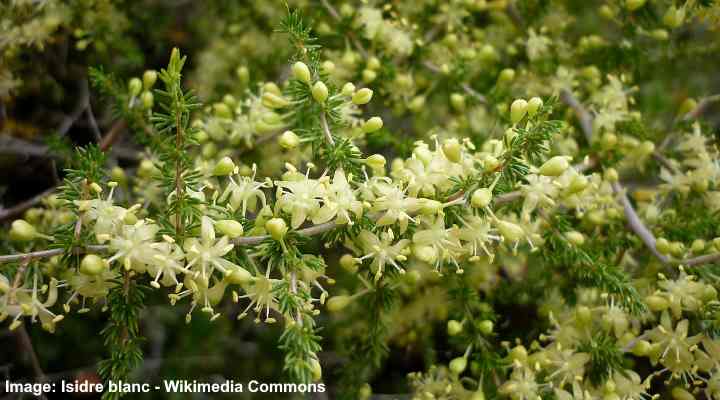
Wild asparagus fern with flowers
Also called common wild asparagus, this evergreen plant has thorny leaves. Wild asparagus has typical fern-like leaves, common to all asparagus plants. The perennial wild asparagus fern grows up to 5 ft. (1.5 m) high and thrives in full sun or partial shade.
Like most asparagus ferns, the wild asparagus species produces clusters of small greenish-white flowers. Its green berries ripen in winter.
Wild asparagus ferns are native to the Mediterranean region. Other botanical names that refer to this species of wild asparagus include Asparagus brevifolius, Asparagus aetnensis, Asparagus corruda, and Asparagus commutatus.
Asparagus Fern Plant Care
Asparagus ferns are easy to care for indoors. All you need is to grow asparagus ferns in a loose, loamy potting mix and keep them in bright indirect sunlight. Water asparagus ferns when the soil dries out and mist regularly to keep humidity levels high. Average room temperatures are ideal.
Asparagus Ferns Light Requirements
Asparagus ferns need plenty of indirect sunlight to thrive. When growing indoors, protect the ferny plant from direct sunlight; otherwise, the leaves may get scorched. Asparagus ferns don’t grow well in dark rooms. So, if the asparagus ferns don’t get enough light, the leaves may start to turn yellow.
The best location indoors to grow asparagus ferns is near a bright window—as long as there is protection from the sun’s direct rays. Growing asparagus ferns on an east-facing windowsill is excellent as the plant gets some morning sun, but no hot midday and evening sunlight.
If you are growing asparagus ferns in your backyard, plant where there is some dappled sunlight.
Too much sunlight is also a reason for the delicate asparagus fern leaves to turn yellow.
The Best Soil for Asparagus Fern Plants
Asparagus ferns grow best in light, aerated soil that drains fast. Mix one part of potting soil and one part of perlite to create a suitable houseplant potting mixture. Organic matter such as peat moss retains some moisture. The addition of coarse sand or perlite helps to improve drainage.
Asparagus ferns are very sensitive to overly-damp soil. In their native habitat, asparagus ferns grow in all types of soil, including poor quality soil. The most crucial soil requirement is that the growing medium doesn’t become too wet or soggy.
Containers for growing asparagus ferns should always have drainage holes to prevent water from pooling in the pot.
How to Water Asparagus Ferns
Only water asparagus ferns when the potting soil has partially dried. Before watering, check to see that the top 2” (5 cm) of the potting mix is dry. Then, thoroughly water the soil until it drains out the bottom of the pot. Always allow the soil to dry between deep waterings.
Asparagus ferns roots are a type of bulb called a tuber. This fleshy plant root stores water. Never water an asparagus fern too often. If the bulbous roots sit in overly-damp soil, the roots will start to rot, and the plant can die. Remember, asparagus ferns are fairly drought-tolerant plants.
Further reading: How often to water houseplants.
Temperature and Humidity for Asparagus Fern Care
Grow asparagus ferns in average room temperatures between 65°F and 70°F (18°C – 21°C). The minimum temperature for asparagus fern plants is 55°F (13°C). Like growing ferns indoors, protect asparagus ferns from temperature extremes, direct sunlight, and cold drafts.
Proper humidity is one of the challenges when caring for asparagus ferns indoors. Indoor humidity levels are usually too dry for healthy asparagus fern growth. So, it’s a good idea to mist the feathery sprays once a day. Spray a fine mist of distilled or filtered water over the foliage crown.
Other ways to ensure proper humidity levels for your asparagus ferns are to use a room humidifier, sit the potted plant on a pebble and water tray, or grow together with other houseplants.
How to Fertilize Asparagus Fern Plants
Fertilizing asparagus ferns can ensure healthy growth—although fertilizing isn’t always needed. You can apply a diluted liquid fertilizer monthly during the growing season to promote lush foliage growth. Use an organic houseplant fertilizer and dilute to half-strength. Apply once a month just after watering your plants.
Please read this article to find out about the best organic fertilizers for houseplants.
Pruning Asparagus Ferns
Asparagus ferns don’t require regular pruning to grow well. However, in spring, you could trim off dead, yellow, or brown foliage to improve the plant’s appearance. It would be best if you pruned off dead stems at their base to remove them. To encourage bushy growth, snip off new stem tips.
Repotting Asparagus Ferns
Asparagus ferns are fast-growing plants that typically need repotting every spring. Remove the plant root ball from the container and repot in a container one to two sizes larger. The tuberous root can quickly outgrow the pot. While asparagus ferns don’t mind being slightly rootbound, you’ll need to repot them regularly.
Signs you need to repot an asparagus fern growing indoors are roots poking out of the pot, soil that starts to drain poorly, or a cracked pot.
When you repot your asparagus fern, use the opportunity to divide the tuber root for propagation.
How to Propagate Asparagus Ferns
To propagate asparagus ferns, divide the thick fleshy root into two or three sections. When propagating asparagus ferns by root division, ensure there are several healthy stems on each section. Also, the sections of bulbous roots should have plenty of shoots. Plant each section of root in fresh potting soil and water thoroughly.
Keeping Asparagus Ferns Free from Pests and Disease
Asparagus ferns are hardy, woody plants that are generally free from bugs and disease. The most common houseplant pests to affect asparagus ferns are mealybugs or scale insects. These pesky bugs suck the sap from healthy plants, weakening their growth.
You should treat asparagus ferns as soon as possible if you notice signs of mealybugs. Insecticidal soap, organic neem oil, and rubbing alcohol are ways to eliminate scale insects and other similar pests.
For more information, please see this article on natural ways to eradicate houseplant bugs.
Asparagus Fern Toxicity
All species of asparagus have toxins that are poisonous to cats and dogs. The American Society for the Prevention of Cruelty to Animals (ASPCA) says that dogs and cats can suffer allergic dermatitis from regular contact with the plant. Also, ingesting the berries can cause vomiting, diarrhea, or abdominal pain.
Related articles:
